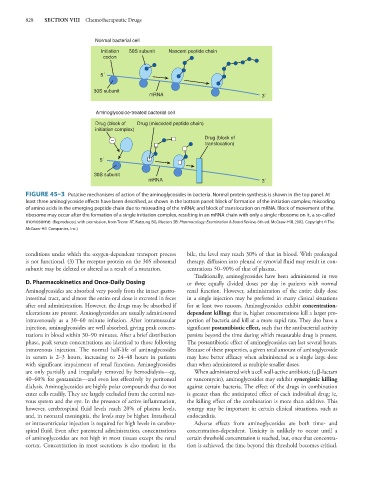Page 842 - Basic _ Clinical Pharmacology ( PDFDrive )
P. 842
828 SECTION VIII Chemotherapeutic Drugs
Normal bacterial cell
Initiation 50S subunit Nascent peptide chain
codon
5´
30S subunit
mRNA 3´
Aminoglycoside-treated bacterial cell
Drug (block of Drug (miscoded peptide chain)
initiation complex)
Drug (block of
–
translocation)
5´
30S subunit
mRNA 3´
FIGURE 45–3 Putative mechanisms of action of the aminoglycosides in bacteria. Normal protein synthesis is shown in the top panel. At
least three aminoglycoside effects have been described, as shown in the bottom panel: block of formation of the initiation complex; miscoding
of amino acids in the emerging peptide chain due to misreading of the mRNA; and block of translocation on mRNA. Block of movement of the
ribosome may occur after the formation of a single initiation complex, resulting in an mRNA chain with only a single ribosome on it, a so-called
monosome. (Reproduced, with permission, from Trevor AT, Katzung BG, Masters SB: Pharmacology: Examination & Board Review, 6th ed. McGraw-Hill, 2002. Copyright © The
McGraw-Hill Companies, Inc.)
conditions under which the oxygen-dependent transport process bile, the level may reach 30% of that in blood. With prolonged
is not functional. (3) The receptor protein on the 30S ribosomal therapy, diffusion into pleural or synovial fluid may result in con-
subunit may be deleted or altered as a result of a mutation. centrations 50–90% of that of plasma.
Traditionally, aminoglycosides have been administered in two
D. Pharmacokinetics and Once-Daily Dosing or three equally divided doses per day in patients with normal
Aminoglycosides are absorbed very poorly from the intact gastro- renal function. However, administration of the entire daily dose
intestinal tract, and almost the entire oral dose is excreted in feces in a single injection may be preferred in many clinical situations
after oral administration. However, the drugs may be absorbed if for at least two reasons. Aminoglycosides exhibit concentration-
ulcerations are present. Aminoglycosides are usually administered dependent killing; that is, higher concentrations kill a larger pro-
intravenously as a 30–60 minute infusion. After intramuscular portion of bacteria and kill at a more rapid rate. They also have a
injection, aminoglycosides are well absorbed, giving peak concen- significant postantibiotic effect, such that the antibacterial activity
trations in blood within 30–90 minutes. After a brief distribution persists beyond the time during which measurable drug is present.
phase, peak serum concentrations are identical to those following The postantibiotic effect of aminoglycosides can last several hours.
intravenous injection. The normal half-life of aminoglycosides Because of these properties, a given total amount of aminoglycoside
in serum is 2–3 hours, increasing to 24–48 hours in patients may have better efficacy when administered as a single large dose
with significant impairment of renal function. Aminoglycosides than when administered as multiple smaller doses.
are only partially and irregularly removed by hemodialysis—eg, When administered with a cell wall-active antibiotic (a β-lactam
40–60% for gentamicin—and even less effectively by peritoneal or vancomycin), aminoglycosides may exhibit synergistic killing
dialysis. Aminoglycosides are highly polar compounds that do not against certain bacteria. The effect of the drugs in combination
enter cells readily. They are largely excluded from the central ner- is greater than the anticipated effect of each individual drug; ie,
vous system and the eye. In the presence of active inflammation, the killing effect of the combination is more than additive. This
however, cerebrospinal fluid levels reach 20% of plasma levels, synergy may be important in certain clinical situations, such as
and, in neonatal meningitis, the levels may be higher. Intrathecal endocarditis.
or intraventricular injection is required for high levels in cerebro- Adverse effects from aminoglycosides are both time- and
spinal fluid. Even after parenteral administration, concentrations concentration-dependent. Toxicity is unlikely to occur until a
of aminoglycosides are not high in most tissues except the renal certain threshold concentration is reached, but, once that concentra-
cortex. Concentration in most secretions is also modest; in the tion is achieved, the time beyond this threshold becomes critical.

